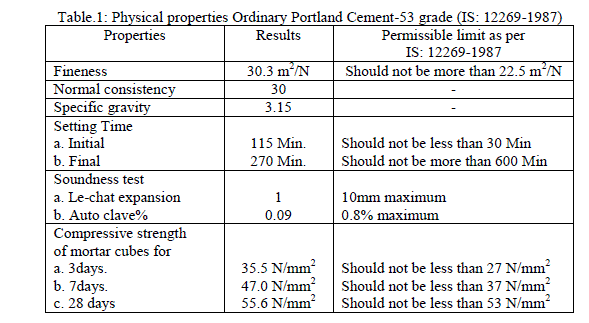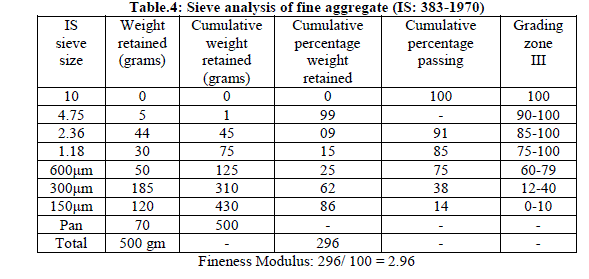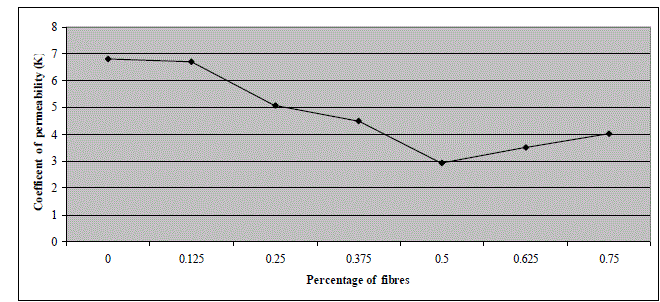ISSN ONLINE(2319-8753)PRINT(2347-6710)
ISSN ONLINE(2319-8753)PRINT(2347-6710)
Prahallada M.C1 and Prakash K.B2
|
| Related article at Pubmed, Scholar Google |
Visit for more related articles at International Journal of Innovative Research in Science, Engineering and Technology
In this paper an attempt has been made to study the permeability characteristics of waste plastic fibres reinforced concrete with the addition of different percentage waste plastic fibres like 0.25%, 0.5%, 0.75%, 1.0%, 1.25%, and 1.5% by weight of cement. Permeability tests were conducted using permeability test apparatus as per the procedure prescribed in IS: 3085-1965. During the test permeability was observed to decrease significantly with the addition of fibres and it was continued to decrease with the increase in fibre content. Considering the strength and durability criteria, it was concluded that waste plastic fibres might be added up to 1% by weight of cement to achieve improved properties.
Keywords |
| Waste plastic fibres reinforced concrete, Coefficient Permeability |
INTRODUCTION |
| Concrete is inherently a porous material. This arises from the use of water in excess of that required for the purpose of hydration in order to make the mix sufficiently workable, and the difficulty of removing all the entrapped air voids from the concrete during compaction. If the voids are interconnected, concrete becomes pervious; although with normal care concrete is sufficiently impermeable for most purposes. |
| Durability of Portland cement concrete ïÃÂÃâº1ïÃÂÃÂis its ability to resist weathering action, chemical attack, abrasion, or any other process of deterioration. A durable concrete will retain its original form, quality and serviceability when exposed to its environment. |
| ïÃâ÷ Water is the primary agent of deterioration. It can be a cause of many physical processes of deterioration, or it can be a vehicle for transport of aggressive ions which cause chemical process of deterioration. |
| ïÃâ÷ The movement of water in concrete is controlled by the permeability of concrete. Permeability is the most important indicator of durability of concrete. |
| ïÃâ÷ Concrete is a basic material; therefore, acidic waters are more harmful to concrete |
| The Knowledge pertaining to permeability determines the durability of concrete to withstand the various attacks either due to internal or external causes ïÃÂÃâº9ïÃÂÃÂ. Corrosion of steel reinforcement in reinforced cement concrete (RCC) structures is usually governed by the cover provided and the permeability of the concrete, and the maximum allowable size of exposed cracks in structures ïÃÂÃâº4, 5ïÃÂÃÂ. The durability of concrete depends a lot upon its resistance to ingress of chemical such as sulphates, acids and chlorides can penetrate concrete. These harmful chemicals can lead to corrosion of steel reinforcement ïÃÂÃâº8ïÃÂÃÂ. Hence, permeability plays important role. |
| Low permeability is an important requirement for hydraulic structures and in some cases water tightness of concrete may be considered to be more significant than strength although, other conditions being equal, concrete of low permeability will normally also be strong and durable. A concrete, which readily absorbs water, may be susceptible to deterioration. Resistance to deterioration is determined largely by the ability of the cover zone concrete to resist the ingress of deleterious agents from the environmentïÃÂÃâº7ïÃÂÃÂ. |
| Permeability is a measure of the concreteâÃâ¬ÃŸs ability to resist penetration of water or other substances. It therefore largely determines the vulnerability of concrete to external agencies, so that in order to be durable, concrete must be relatively impervious. The more water the concrete contains beyond that necessary for workability, the more pervious it will become. It is important to remember that the permeability of concrete should be kept low in order to protect the reinforcing steel bar contained within or if concrete issued for water retaining structureïÃÂÃâº6ïÃÂÃÂ. The durability of concrete is as such dependent on the permeability of concrete, which is defined as the ease with which it allows the fluids to pass through it. It has been well established that the permeability of concrete is directly proportional to the amount of harmful chemicals such as sulphates and chlorides entering into it. The effect of concrete constituents such as cement content, type and size of aggregates, curing conditions etc. on the permeability of plain concrete has been thoroughly investigated. Even though permeability is considered as a key factor affecting durability, only scanty literature is available on permeability of FRC. The permeability of SFRC is likely to be influenced by mix ingredients and fibre parameters such as fibre content, aspect ratio and fibre shape ïÃÂÃâº8ïÃÂÃÂ. |
| Generally, the specifications on the cover thickness are based upon the type of structural element and the environment to which it is exposed. Use of fibre in concrete, ensures effective bridging of fibres across the inherent micro flaws and improves the strength and behavior of the cement concrete. Steel fibre reinforced concrete (SFRC) is being used in many engineering applications where the formation and propagation of cracks are to be controlled. But the application of SFRC is limited, due to the corrosion possibilities of the partially exposed fibre filaments on the surface. In such a situation, a non-corrosive fibre seems to be appropriate ïÃÂÃâº4ïÃÂÃÂ. In this experimental investigation, the behavior of the cement concrete reinforced with locally available waste plastic fibre, a typical non-corrosive and nonbiodegrade/ non-perishable fibre has been studied. |
II. MATERIALS USED AND METHODS |
| Cement: Ordinary Portland Cement-53 grade was used having a specific gravity of 3.15 and it satisfies the requirements of IS: 12269-1987 specifications. The physical properties of tested cement are given in Table No.1 |
 |
| Coarse aggregates: The crushed stone aggregate were collected from the local quarry. The coarse aggregates used in the experimentation were 10mm and down size aggregate and tested as per IS: 383-1970 and 2386-1963 (I, II and III) specifications. The aggregates used were having fineness modulus 1.9. Sieve analyses of coarse aggregate are given in Table No.2 and physical and mechanical properties of tested coarse aggregates are given in Table No.3 |
 |
| Fine aggregates: Locally available sand collected from the bed of river Bhadra was used as fine aggregate. The sand used was having fineness modulus 2.96 and confirmed to grading zone-III as per IS: 383-1970 specification. Sieve analyses of fine aggregate are given in Table No.4 and physical properties tested for fine aggregate are given in Table No.5 |
 |
 |
| Fibres: The waste plastic fibres were obtained by cutting waste plastic pots, buckets, cans, drums and utensils. The waste plastic fibres obtained were all recycled plastics. The fibres were cut from steel wire cutter and it is labour oriented. The thickness of waste plastic fibres was 1mm and its breadth was kept 5mm and these fibres were straight. The different percentage of fibres and suitable aspect ratio were selected and used in this investigation. Physical properties of these fibres are given in Table No.6 |
 |
| Water: Ordinary potable water free from organic content, turbidity and salts was used for mixing and for curing throughout the investigation. |
| Superplasticizer: Superplasticizer (Conplast SP-430) was used. The dosage of superplasticizer adopted in the experimentation was 1% (by weight of cement). |
| Moulds: The sizes of the permeability specimens were of dimension 100mm diameter and 100mm height. All the time, inner surfaces of steel moulds were lubricated before placing wet concrete for easy demoulding. |
| Concrete was prepared by a mix proportion of 1: 1.435: 2.46 with a W/C ratio of 0.48 which correspond to M20 grade of concrete. The different percentages of waste plastic fibres adopted in the programme by volume fraction are 0%, 0.125%, 0.25%, 0.375%, 0.5%, 0.625% and 0.75%. The aspect ratio adopted for the waste plastic fibres was 50. The permeability test specimens were of dimensions 150mm x 150mm in diameter. The permeability test specimens were cast and tested after 28 days of curing as per IS specifications. Testing of permeability of concrete was done in accordance with IS: 3085-1965 (method of test for permeability of cement mortar and concrete). This standard covers the method for determining the permeability of concrete or mortar specimen either cast in laboratory or obtained by cutting out cores from existing structures. The test consist in subjecting the concrete specimen of known dimension, contained in a special designated cell, to know a hydrostatic pressure from one side measuring the quantity of water percolating through it in given interval of time and computing the coefficient of permeability cell has a cross section of diameter 115mm and height 115mm. A reservoir was connected to the cell by means of a metal pipe of 50 to 100mm in diameter and about 500mm long. The reservoir shall be fitted with a graduated side arm gauge glass and necessary fitting and valves for admitting water and compressed air and for draining bleeding and connection to the permeability cell. Suitable arrangements were made for maintaining a pressure at 0 Kg/cm2 to 15 Kg/cm2 to permeability cell assemblies. An adequate supply of clean de-aired water shall be available for use in the permeability test. After 28days of water curing the specimens were washed thoroughly cleaned with a stiff wire brush to remove all laitance, the specimen shall be surface dried and the dimensions were measured to the nearest 0.5mm. It shall then be kept in the cell. The annular space between the specimen and the cell was carefully filled with the molten sealing compound level with the top of the specimen. It is essential that the seal is watertight. After a satisfactory seal has been obtained the funnel shall be secured in position and the cell assembly connected to the reservoir. With a bleeder valve, the valve between the reservoir and the cell, and the drain-cock in the open cell, de-aired water shall be allowed to enter the reservoir. When water issues freely through the drain cock, it shall be closed and the water reservoir filled. The reservoir water inlet and air bleeder valve shall then be closed. With the system completely filled with water, the desired test pressure shall be applied to the water reservoir and the initial reading of gauge-glass readings shall be recorded at periodic intervals. In the beginning, the rate of water intake is larger than the rate of flow. As the steady state of flow is approached, the two rates tend to become equal and the outflow reaches a maximum and stabilizes. With further passage of time, both the inflow and out flow generally register a gradual drop. |
| The coefficient of permeability shall be calculated as follows. |
| K = Q/ (A x T (H/L) |
| Where, K = coefficient of permeability in cm/sec; |
| Q = Quantity of water in millimeters percolating over the entire period of test after the steady state has been reached; |
| A =Area of the specimen in cm2 |
| T = time in seconds over which Q is measured and |
| H/L = ratio of the head to thickness of the specimen, both expressed in the same units. |
III EXPERIMENTAL RESULTS |
| The following Table gives the details of the experimental results |
| Coefficient of Permeability Test Results -The following Table No.7 gives the coefficient of permeability test results of waste plastic fibre reinforced concrete with different percentages of waste plastic fibres. It also gives the percentage increase or decrease of coefficient of permeability. |
 |
| The variation of coefficient of permeability of waste plastic fibre reinforced concrete can be depicted in the form of graph as shown in Figure.1 |
 |
IV OBSERVATIONS AND DISCUSSIONS |
| Based on the experimental results the following observations were made |
| 1. It has been observed that the coefficient of permeability goes on decreasing upto 0.5% waste plastic fibre addition. More than 0.5% addition of fibres is not desirable as coefficient of permeability increases |
| This may be due to the fact that 0.5% addition of waste plastic fibre, may average results in dense concrete filling all the voids. Also it may be due to the fact that addition of 0.5% waste plastic fibre may reduce shrinkage cracks. |
| 2. It is observed from the literature (Tensing. D et al.,) that addition of 0.5% of steel fibres result in coefficient of permeability K=3. The addition of 0.5% of waste plastic fibres results in the value of K as 2.93. Thus, steel fibres and waste plastic fibres have all most the same effect on permeability of concrete. |
V CONCLUSIONS |
| The following overall conclusions can be drawn from the experimental investigations carried out |
| 1. Addition of waste plastic fibres results in significant decrease in permeability |
| 2. Concrete with 0.5% waste plastic plastic fibres (by volume fraction) can improve the impermeability characteristics. |
VI ACKNOWLEDGEMENTS |
| The authors would like to thank Vice-Chancellor, Christ University, Fr. Benny Thomas, Director and Dr. Iven Jose, Associate Dean, Christ University Faculty of Engineering, Bangalore for their constant encouragement |
References |
|